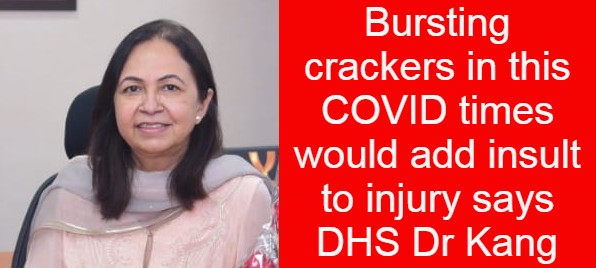M4PNews|Chandigarh
Diwali, bursting crackers and it’s after effects, that a normal every year routine. But, 2020 has a different time, different issues, different air quality, and A Virus to deal with. So, it becomes pertinent to tell people of Chandigarh to stay away from bursting crackers as it could worsen the COVID situation says Dr. Amandeep Kang, Director Health Services. While thanking the UT Administrator and Punjab Governor VPS Badnore for banning the crackers in the city, DHS talks about bursting Crackers and shared her thoughts on this issue.
During Diwali, there is a sudden deterioration in the air quality due to the increased concentration of air pollutants all over North India. Firecrackers contain chemicals like sodium oxalate, aluminum, arsenic, sulfur, manganese, iron dust powder, potassium perchlorate, strontium nitrate, and barium nitrate, etc. which have serious ill effects on human health. The burning of firecrackers also produces gaseous pollutants SO2 and NO2 and huge amounts of ambient particulates into the atmosphere that generates dense clouds of smoke. The concentrations of these gases as well as particulate pollutants PM10 and PM2.5 are 2-6 times higher during the Diwali festival.
These air pollutants stimulate the ACE-2 receptors on the respiratory nasal cells, thus increasing permeability to the SARS-COV-2 Virus to easily enter these cells and establish infection in the nose, throat, and lungs. Due to air pollution, the aerosols of the SARS-COV-2 virus produced by an infected person will remain afloat in the air for longer periods longer than 10-20 minutes resulting in increase transmission of COVID-19. Studies have also shown that 15% of COVID Deaths are due to air pollution and the case fatality rate of COVID-19 can increase in the elderly and persons with co-morbidity. As winter, sets in dry air could aggravate breathing difficulties, especially among those suffering from lung ailments. If we add smoke to the ambient air by bursting crackers, then it could turn out to be a recipe for disaster. Even those who have recovered from the COVID-19 virus will become vulnerable if we do not restrain ourselves during Diwali. It is advised that the public should avoid bursting firecrackers during Diwali.
The increased concentration of SO2, NO2, and suspended particulate matter has severe health impacts on cardiovascular diseases, respiratory health effects such as asthma, bronchitis, allergic bronchitis, acute exacerbation of bronchial asthma, chronic bronchitis emphysema, Chronic Obstructive Pulmonary Disease (COPD), allergic rhinitis, laryngitis, sinusitis, pneumonia. Emission of trace elements such as As, Cd, Co, Cr, Ni is carcinogenic to humans. Cd exposure is a risk factor for chronic lung diseases. Cr has a carcinogenic effect on the bronchial tree. Noise pollution due to fireworks not only distracts our attention but also causes psychological stress. The most dangerous effect of noise from firecrackers is the loss of hearing ability, which may be temporary or permanent depending on the time of exposure. Excessive noise may cause severe sleep disturbance, fatigue, and irritation due to community noise. Continuous noise levels increase the cholesterol level, which increases the possibility of heart attacks.
The Director of Health Services Dr. Kang advises that people should stay indoors and desist from bursting firecrackers during this Diwali so that we can protect the elderly and people with co-morbidities. Public cooperation in this will help in keeping the transmission of COVID-19 under control and decrease the risk of mortality due to COVID-19 in the coming winter months.
